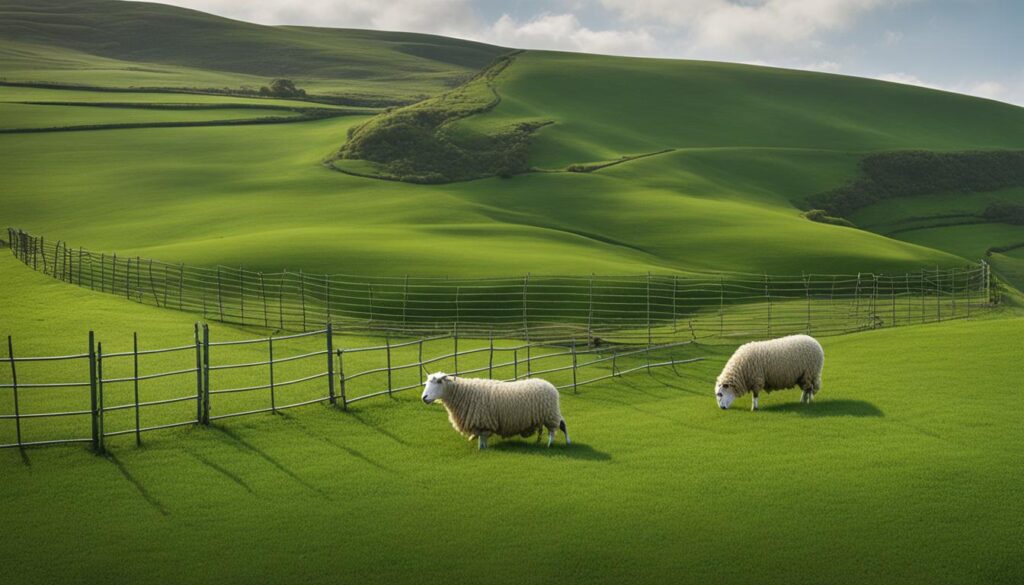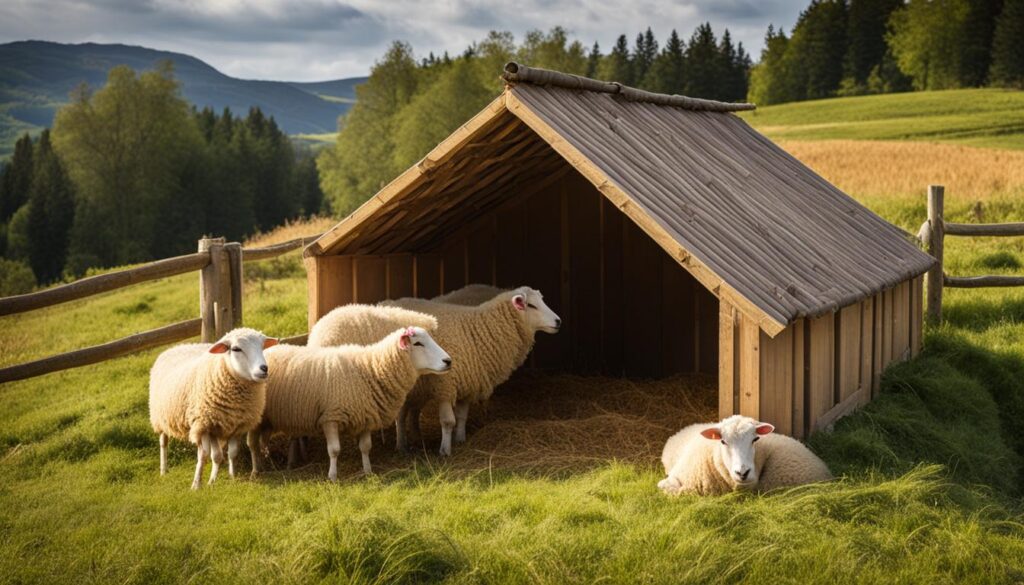Embarking on a journey as a hobby farmer, I quickly learned that grazing sheep can be as much a connection to the land and animals as it is a numbers game. For subsistence homesteaders like myself, grasping the ins and outs of cost-effectiveness in sheep farming practices isn’t just wise—it’s essential for sustainability. I want to share my personal exploration into the costs involved with sheep grazing per acre, a path paved with both financial investment and the rewards of a life more closely entwined with nature.
Key Takeaways
- Understanding the full spectrum of grazing costs is essential for hobby farmers.
- Investment in proper infrastructure is critical at the outset, especially for substance homesteaders.
- Cost-effectiveness requires a balance of initial outlays with ongoing expenses.
- Connecting with the land and livestock is an invaluable part of the sheep grazing endeavor.
- Achieving a sustainable farming practice revolves around effective cost management and resource utilization.
Early Considerations for Pasture Setup and Associated Costs
The journey of converting raw land development into a functional space for sheep grazing infrastructure is one rife with exciting challenges and crucial decisions. When I initially embarked on establishing my 10-acre pasture, my focus was to have a comprehensive view of the pasture setup cost, ensuring every step was not only intentional but also economical.
Understanding the lay of the land was the starting point. The groundworks involved fenceline clearing and the installation of reliable perimeter fencing. These were fundamental to paddock security and the overall welfare of my sheep.
Financial prudence dictated that I record every expense, no matter how small, to gain a true picture of my investment. Below is a detailed table that accounts for the initial setup costs, reflecting the reality of turning raw land into productive pasture:
| Infrastructure Component | Cost Range (USD) | Notes |
|---|---|---|
| Fenceline Clearing | $500 – $3,000 | Varies by land condition and foliage density |
| Perimeter Fencing Materials | Approximately $3,824 | Cost-effectiveness balanced with durability |
| Corner Braces and Gate | $913 | Essential for maintaining the structural integrity of the fence |
| Total Estimated Fencing Cost | $4,637 – $7,137 | Comprehensive coverage including labor |
Through careful planning and execution, I discovered ways to reduce costs without compromising on quality. For instance, the utilization of on-site materials helped with corner braces construction, which incidentally eased the burden on my budget.
While the table captures hard numbers, there’s also a softer, intangible aspect to this process. It’s the satisfaction of personally developing land to support the gentle meandering of sheep across a pasture made secure by my own hands. This venture, grounded in raw land and culminating in the serene grazing of livestock, represents the epitome of a farmer’s dedication to the land and his flock.
Understanding the Variable Expenses of Fencing and Water Access
As I expanded my operations and delved into the nuances of managing a pasture, I learned quickly that efficiency and cost-effectiveness were pivotal to the endeavor. My approach to creating a cost-effective perimeter security has been influenced heavily by my choice in fencing materials and ensuring my livestock’s hydration without breaking the bank.
Breaking Down Fencing Costs: What Worked for Me
The backbone of farm security lies in the strength and reliability of its fences. I chose a durable woven wire field fence, known for its functionality and resilience. Stretching my dollar while constructing these barriers was crucial, and the prices I encountered reflected both the quality of the material and the overall affordability of my project.
For a 330 linear feet stretch of woven wire fencing, the cost was $478, which proved to be a worthwhile investment for the long-term security of my flock.
Incorporating corner braces fashioned from treated lumber, which was repurposed from the initial land clearing, epitomized resourcefulness and sustainability, saving costs and the environment simultaneously.
Innovative Water Solutions on a Budget
Navigating the sheep water requirements not only entailed ensuring they had constant access but also doing so in a budget-friendly manner. The implementation of UV resistant Poly-tubing has been a game-changer for livestock hydration.
I avoided the steep costs associated with pond excavation by laying down a 500-foot span of this cost-effective tubing, which came in at just $200, thereby ensuring that fresh water was never out of reach for my sheep.
This tubing partnered with multiple water tanks introduced efficiency and a sense of balance between practicality and economy.
The True Price of Accessibility: Gates and Entryways
Fencing is only one facet of farm security; having secure livestock access points is another. Gate installation costs can quickly add up, but through careful planning and shopping around for quality utility tube gates, I was able to maintain security without forgoing cost-effectiveness.
| Material | Quantity | Cost |
|---|---|---|
| Utility Tube Gate | 1 | $217 |
| Hinge Kits | 2 | $36 |
| Treated Posts | 2 | $60 |
| Total | N/A | $313 |
The reliable gates now provide easy and secure access, reinforcing both the day-to-day operations and the integrity of my pastoral sanctuary.

Cost of Sheep Grazing Per Acre: My Practical Findings
As a hobby farmer dedicated to sheep grazing, managing costs is paramount. My experience has taught me that sheep grazing price per acre fluctuates widely, influenced by a host of factors including locale and the terms of any livestock grazing agreements. Here, I want to share my hands-on insights into optimizing both the land and economics of sheep farming.
Navigating the Fluctuations in Grazing Prices
Geographical variations impact the realistic grazing costs significantly. A compelling case study was a neighboring landowner’s experience. They secured a deal to allow 50 ewes to graze for an annual sum of $2,000 across 20 acres. This example underscores how vital it is to understand the regional market to craft mutually beneficial and sustainable sheep grazing contracts.
Maximizing Acreage: How Many Sheep Per Acre Is Cost-Effective?
In lush regions, I’ve seen that 2-3 sheep per acre maintain the health of both the pasture and the sheep. Yet, starting with a conservative sheep stocking rate of one sheep per acre can forestall financial strain and support your commitment to acreage optimization and expansion with quality breeding stock.
Sheep Grazing Price Per Acre vs. Potential Revenue
The balance between expenditures and earnings in sheep farming is striking. Rates ranging from $100 per acre annually for pasture leasing income to weekly per head charges necessitate a keen grasp of both expenses and secondary gains like natural weed control.
| Acreage | Leasing Income (Annual) | Grazing Lease Rates (Per Head/Week) | Potential Revenue from Sheep Farming |
|---|---|---|---|
| 10 Acres | $1,000 | $1.50 | $3,000 |
| 20 Acres | $2,000 | $1.75 | $7,000 |
| 50 Acres | $5,000 | $2.00 | $18,000 |
Through close examination and laying bare the figures as above, we grasp the true nature of sheep farming profitability. With these practical evaluations, farmers can navigate toward a more fruitful journey with their beloved flocks.
Incorporating Shelter and Security Without Breaking the Bank
When it comes to providing sturdy, cost-efficient sheep shelters, I’ve found that creativity and cooperation with reputable companies can lead to substantial savings. Partnering with a known manufacturer, I’m in the process of securing an affordable farming structure that doesn’t compromise on the necessary livestock protection. Falling well within the budget at $2,200, this 10×20-foot enclosure is designed to withstand the challenges of the great Texas outdoors. Prioritizing the animals’ well-being while maintaining financial responsibility is the key to a successful and sustainable setup.
- Durable shelters provide essential refuge from extreme weather
- Strategic positioning with the closed side facing north for wind protection
- The use of dry bedding contributes to an insulated and comfortable environment
Affordable doesn’t have to mean lower quality. Through careful planning and selecting the right materials, my investment in a shelter ensures comprehensive protection for the flock. This method strikes a functional balance between cost and security, providing peace of mind that my livestock are safe, come rain or shine.
“A proper shelter is a cornerstone of livestock well-being. Investing in a structure that offers protection and durability is essential for the longevity of your sheep farming venture.”
Moreover, seeking cost-efficient solutions has not only reduced my initial outlay but also minimized future maintenance expenses. In addition to a solid shelter, choosing the right bedding materials adds an extra layer of insulation, contributing to healthier and happier sheep throughout the seasons.

In summary, layering smart design choices and leveraging the market has led me to a solution that ticks all the boxes: affordability, durability, and comfort for the sheep. It’s a testimony to the fact that well-thought-out investments in shelters and security can be accomplished without draining the farm account—an essential consideration for every cost-conscious farmer.
My Approach to Rotational Grazing and Its Financial Implications
Embarking on rotational grazing was a deliberate move to enhance my pasture’s longevity and yield. This method, known for its numerous rotational grazing benefits, involves meticulous planning and initial expenses that can impact the economics of sheep farming. I took the plunge, investing in essential sheep grazing equipment and pasture management tools necessary for effective land utilization. Despite the upfront cost of setting up the grazing system, the long-term expectations of labor efficiency, pasture sustainability, and reduced feed costs made the decision a calculated one.
Essential Supplies for Rotational Grazing
Gearing up for rotational grazing meant securing various items such as reels, polytape rolls, and step-in posts that form the backbone of a movable grazing setup. The total came to $687, not an insignificant sum by any means. It was clear that these were foundational investments in a long-term farming strategy that promised to be more budget-friendly compared to traditional grazing practices. With the supplies ready, the process of managing the shifts of my flock became streamlined, speaking to the promise of labor efficiency in a rotational system.
Calculating the True Investment of Time and Money in Rotational Systems
Prior to transitioning, I assessed the grazing system costs, not just in terms of financial outlay but also the time required to manage the system efficiently. In addition to purchasing initial supplies, I allowed for an extra $1,500 buffer to cover any unexpected expenses. This enduring commitment pulls in the aspect of financial foresight and preparedness, incorporating both tangible investments and the invaluable input of time and continuous learning. Moreover, the attention to thorough management echoes the ethos of long-term investment in both the health of the livestock and the productivity of the land.
Is Rotational Grazing a Viable Cost-Saving Strategy?
After thoroughly analyzing my inputs and the outcomes over time, I can assert that rotational grazing is indeed a cost-effective approach. The dividends paid by way of enhanced forage quality, decreased reliance on supplementary feeds, and the overall improvement in pasture health are hard to ignore. These factors collectively underscore long-term pasture sustainability. In the economics of sheep farming, such budget-friendly grazing practices can provide a significant edge, making rotational grazing not just viable but advisable for those looking to maximize their acreage’s potential.

